Eco-friendly red wigglers: For organic gardening
Eco-friendly red wigglers: For organic gardening
Blog Article
Using Red Wigglers for Effective Organic Waste Disposal
These worms not just enhance waste decomposition however also produce useful worm castings, which can considerably improve soil wellness. Recognizing the nuances of setting up an effective worm bin and maintaining an optimum environment is important for maximizing their benefits.
Benefits of Using Red Wigglers
Among the most engaging advantages of using red wigglers for organic garbage disposal is their impressive effectiveness in composting. These worms, scientifically called Eisenia fetida, are especially adjusted for damaging down natural products, allowing them to process waste as much as two times their body weight daily. This fast decomposition not just increases the composting procedure yet also creates nutrient-rich worm spreadings that significantly improve dirt top quality.
Additionally, red wigglers add to a reduction in landfill waste. By drawing away organic products from landfills, they help lessen methane discharges-- a powerful greenhouse gas. This ecological advantage is critical in the battle against climate adjustment.
Additionally, red wigglers are low-maintenance and can grow in numerous atmospheres, making them easily accessible for both novice and seasoned composters. Their capability to duplicate quickly ensures a steady population, facilitating recurring waste handling.
Establishing Your Worm Bin
Developing a reliable worm container is vital for optimizing the advantages of composting with red wigglers. Make sure the container has sufficient water drainage holes to prevent excess wetness, as red wigglers flourish in a moist but not soggy atmosphere.
(red wiggler worms for sale)Next, prepare the bedding product, which acts as the worms' environment and food resource. Shredded newspaper, cardboard, and coconut coir are outstanding choices. Aim for a bed linen depth of around 4 to 6 inches. The bin should be placed in a dark, temperature-controlled area, preferably between 55 ° F and 77 ° F, to keep worm activity.
When the container is established, present the red wigglers, enabling them to accommodate to their brand-new environment. It's critical to keep an eye on moisture levels and temperature frequently. A well-kept bin will certainly not only support the health and wellness of the worms but likewise promote effective decay of natural waste. By adhering to these guidelines, you can create a flourishing community that adds to sustainable waste administration.
(Western North Carolina Bait)
What to Feed Red Wigglers
An understanding of the proper diet for red wigglers is important for preserving a healthy worm populace and optimizing composting efficiency. These items not just provide vital nutrients yet also add to the moisture balance within the worm container.
It is vital to stay clear of certain foods that can hurt the worm population. Red wigglers need to not be fed meat, dairy items, oily foods, or refined things, as these can bring in parasites and produce undesirable odors. red wigglers. In addition, citrus fruits and hot foods should be lessened, as their level of acidity can be damaging to worms
Keeping track of the worm bin for food consumption prices will certainly help ensure that red wigglers are receiving an ample diet while preserving a reliable composting atmosphere. Appropriate feeding techniques are crucial for cultivating a flourishing ecological community within the worm bin.
Keeping Your Worm Habitat
A properly maintained worm habitat is vital for the wellness and performance of red wigglers. To guarantee ideal conditions, it is important to keep track of temperature level, dampness, and aeration within the worm bin (red wigglers).
A good rule of thumb is to preserve wetness at roughly 70% to 80%. If the bedding becomes too wet, it can lead to anaerobic problems that are unsafe to the worms.

Using Worm Castings in Horticulture
Rich in nutrients and helpful bacteria, worm castings serve as an exceptional organic plant food for horticulture. Generated with the gastrointestinal procedures of red wigglers, these castings have a range of essential nutrients, consisting of nitrogen, phosphorus, and potassium, which promote durable plant growth. Unlike synthetic fertilizers, worm spreadings use a slow-release device, guaranteeing that nutrients are readily available to plants over a prolonged period, therefore lowering the risk of nutrient leaching and soil deficiency.
Along with vitamins and mineral material, worm castings enhance dirt more helpful hints framework and aeration, enhancing moisture retention and drainage. The microbial life present in worm spreadings assists to suppress microorganisms and promotes a healthy soil community, more benefiting plant health. When integrated into the dirt or made use of as a top clothing, worm spreadings can significantly boost seed germination prices, origin growth, and total plant vigor.
For optimum results, garden enthusiasts need to apply worm castings at a price of 1-2 inches per square foot, mixing them into the soil or including them right into potting blends. On the whole, using worm castings is a green approach to enriching soil fertility and making certain prospering yard environments.
Verdict

Report this page